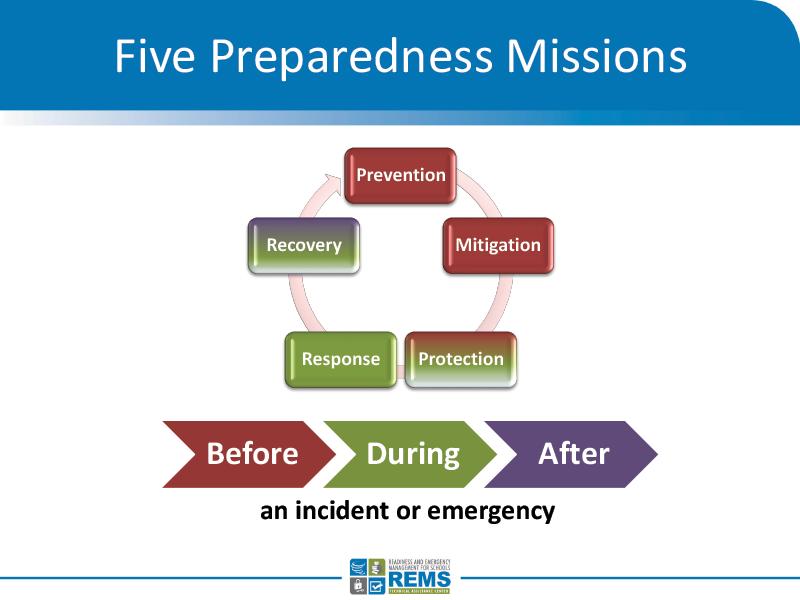These five mission areas are defined by the National Preparedness Goal and are used to organize the elements needed to achieve the goal. The National Preparedness Goal, released in September 2011, defines what it means for the whole community to be prepared for all types of disasters and emergencies.
The goal itself is succinct: "secure and resilient nation with the capabilities required across the whole community to prevent, protect against, mitigate, respond to, and recover from the threats and hazards that pose the greatest risk" These risks include events such as natural disasters, disease pandemics, chemical spills and other manmade hazards, terrorist attacks and cyber attacks.
Five (5) Mission Areas
- Prevention
-
Select a topic to find helpful resources and links.
Adult Sexual Misconduct
Anonymous Reporting
Bomb Threats
Bullying & Harassment
Concussion & Traumatic Brain Injury
Discipline in Schools
Evidence-Based Programs
First Aid & CPR
Hazing
Information Sharing
Internet Safety & Digital Responsibility
Marijuana
Mandatory Reporting
Mental & Behavioral Health
Parent & Family Engagement
Positive School Climate
School Engagement & Dropout Prevention
School Health
School Physical Environment
Security
Social & Emotional Learning
Social Norms
Substance Abuse
Suicide
Teen Dating Violence
Threat Assessment
Transportation
Violence
Vulnerability Assessment
- Mitigation
-
Bullying & Harassment
Community Oriented Policing Services (COPS)
Concussion & Traumatic Brain Injury
Discipline in Schools
Emergency Operations Planning (EOP)
First Aid & CPR
Large Event Preparedness, Response & Recovery
Mental & Behavioral Health
NIMS & ICS
Natural Disasters
Parent & Family Engagement
Positive School Climate
School Health
School Physical Environment
Security
Suicide
Transportation
Trauma
Vulnerability Assessment
- Protection
-
Bomb Threats
Community Oriented Policing Services (COPS)
Continuity of Operations (COOP) Planning
Emergency Operations Planning (EOP)
Information Sharing
Large Event Preparedness, Response & Recovery
Mandatory Reporting
NIMS & ICS
Natural Disasters
Preparedness
School Health
School Physical Environment
Security
Threat Assessment
Transportation
Transportation
Violence
Vulnerability Assessment
- Response
-
Bomb Threats
Bullying & Harassment
Community Oriented Policing Services (COPS)
Continuity of Operations (COOP) Planning
Discipline in Schools
Emergency Operations Planning (EOP)
Evidence-Based Programs
First Aid & CPR
Internet Safety & Digital Responsibility
Large Event Preparedness, Response & Recovery
Mandatory Reporting
Marijuana
Mental & Behavioral Health
NIMS & ICS
Natural Disasters
Parent & Family Engagement
Response
Reunification
School Health
School Physical Environment
Security
Substance Abuse
Suicide
Teen Dating Violence
Violence
- Recovery
-
Concussion & Traumatic Brain Injury
Evidence-Based Programs
Mental & Behavioral Health
Parent & Family Engagement
Recovery
Reunification
School Health
Suicide
Trauma

